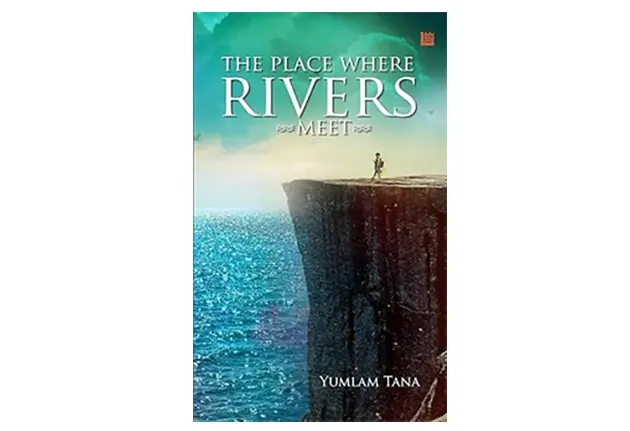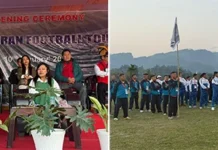TribalBookworms
[ Dr Doyir Ete Taipodia ]
“Revenge is a dish best served cold,” is how the blurb of Yumlam Tana’s novel The Place Where Rivers Meet (2020) begins. It hints at the novel’s central theme of blood revenge. A death in the present is deeply connected to old sins and an intergenerational curse.
The story unfolds as a layered tragedy: the brutal murder of the protagonist, the sorrowful fate of two lovers, and the curse cast upon a tribal clan by a female hornbill, all tracing back to the heinous death of an elderly man generations ago. Tana’s narrative spans past, present, and future, focusing on the fortunes and misfortunes of the Kiki family, members of a powerful Nyishi clan. The Kiki Nyishi of Yamne village pride themselves on a lineage that has inhabited the region since ancient times. The narrator is one of its last remaining members, a descendant of a formidable hunter named Patey Kiki, whose name he also bears. This resemblance, both in name and lineage, becomes increasingly intertwined as the story develops. The single narrator’s voice is distinctive: it is at once weary and prophetic, morally perceptive yet emotionally open. He is troubled by the corruption and compromises of modern life, unable to detach from the whirlwind of worldly entanglements, yet hopeful for a better future. Tragically, this dream is shattered by his murder, an act that reveals he had long been entangled in a web of ancestral sin, a burden he only realises in death. The narrator, despite his innocence, becomes an unfortunate casualty simply because he shares the name and bloodline of his ancestor.
As the story unfolds, it peels back layers of motives and deeds, each bearing its own backstory. The desire for revenge persists relentlessly until the narrator confronts the shadowy pursuer, symbolising the curse that has been hunting the Kiki clan. The narrator is named Patey Kiki Jr. He is an unassuming young man trying to find his place in a society undergoing rapid change, some of it for the better, much of it for the worse. As education gradually reaches the villages and towns, it introduces a wave of modernity that has captivated many youths into what might be called Western ‘low culture’. Patey Jr remains deeply fascinated by the oral traditions passed down by his Natu (grandfather) and Nayu (grandmother), especially the AbuTani stories, which are his favourites. His personal quest is to reach the fabled place ‘‘where rivers meet,” a symbolic destination that seems to foretell both past events and his own future fate.
The novel is divided into three parts, each essential to unravelling the tangled threads of the plot. Layer by layer, the story unfolds for the reader, even as the narrator, too, in his afterlife, continues to make sense of what has happened.
The most compelling aspect of the novel is its retelling of the saga of the great ancestor, Patey Kiki Sr. Beginning in 1855, the narrative follows his life in the ancestral village, his beautiful and sensuous sixth wife, Mipi Kiki, and her forbidden love for the slave boy, Siji Mali. Interwoven in this haunting tale is the figure of a shrewd Nyub (priest), who employs his augury powers to pursue personal vengeance. He manipulates the men of the Kiki clan to hunt down an innocent man who was his rival in love, setting in motion a cycle of blood revenge that steadily passes through generations, eventually reaching the narrator. The symbolic tale of a hornbill couple further deepens this theme. Alongside the tragic love story of Mipi Kiki, the mistress, and Siji Mili, the slave boy, the hornbill narrative introduces another layer of tragedy to the novel. Unknowingly, Patey Kiki Sr kills a male hornbill, the devoted mate, while he was out searching for food for his nesting partner and their chicks.
As is well known, hornbills mate for life. During nesting, the female is sealed inside the hollow of a tree trunk with her young, with only a narrow slit left for food to be passed in, which serves as protection from predators. With her mate gone, the female hornbill and her chicks are doomed. Her dying curse casts a shadow over the Kiki clan, whose members begin to suffer its consequences across generations.
Set against the backdrop of places like Parey Sala, Yamne Village, Tamak Hapa, and many more, the narrative weaves through the quiet corners of the Tara mountains and the Pahm river that cuts across the terrain. Here, stories of love, betrayal, and savagery unfold in all their intensity. The novel raises profound questions, particularly about the tradition of blood revenge, which even claims the narrator as its victim. Mipi’s love affair with her husband’s slave boy also prompts reflection on deeper issues: the tension between personal desire and social approval, the cultural constraints placed on women, and the moral questions that emerge when love challenges hierarchy, ownership, and taboos.
The Place Where Rivers Meet is a beautiful example of contemporary indigenous storytelling from Arunachal Pradesh. It weaves folklore, history, and human vulnerability into a narrative that resonates with both local and universal audiences. Tana’s work reminds us that memory is never purely personal; it is ancestral, inherited, and often, inescapably tragic. The narrator’s voice from the afterlife enhances the novel’s postmodern element, and together with experiments with time, the indigenous narrative framework also greatly contributes to the overall structure. The narrator, Patey Kiki Jr, interacts with the modern world but also draws upon deep, ancestral, or mythic time, where personal memory merges with collective memory. He may not have directly experienced the past, but he is connected to it through his visions, dreams, and participation in the social and cultural rituals of his community.
The narrative tone has a duality; there are vivid descriptions of forest life, ancestral memory, and lives from long ago. These sections draw readers into a nostalgic past which is rooted in myth, memory, and nature. However, at times, the language intentionally has a rough edge, especially when referencing promiscuous jokes, with undertones of crude humour seen in both the older and younger men in the story. The author’s aim for realism, to depict characters as they are in everyday life, including how they might have spoken, can at times come across as jarring or blunt. However, this very quality heightens the raw authenticity of lived experience. What enriches the narrative further are its more lyrical and philosophical passages, especially the evocative descriptions of the tribal world and its worldviews.
The novel’s multiple plotlines are essential to understanding the core of the story. It shows how both deliberate and unforeseen forces operate in the universe, sometimes making us mere playthings in the hands of the gods, and at other times confronting us with the consequences of our own actions. It reminds us of the Shakespeare lines: “As flies to wanton boys are we to the gods; they kill us for their sport.” The novel is a rabbit hole narrative, not in the sense of the fantastical, but rather in how it transports one into a world shaped by invisible forces, traditions, and existential questions. It deeply engages story, history, and community, coming together to create a profoundly engaging and meaningful narrative. (Dr Doyir Ete Taipodia is Assistant Professor, English department, RGU)


